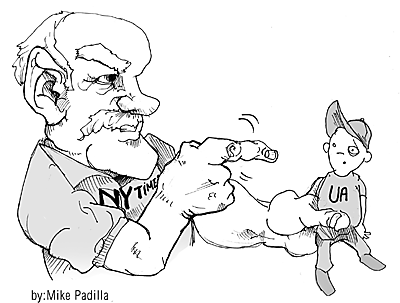
Illustration by Mike Padilla
|
|
By Damion LeeNatali
Arizona Daily Wildcat
Friday, April 29, 2005
Print this
It was a study in contrasts. Standing before the student body's academic and leadership elite, Arizona women's swim head coach Frank Busch was awed by the "impressive gene pool" in attendance at the UA's annual Evening of Excellence, even as students buzzed about a Sunday article in The New York Times that caricatured our university as nothing more than a springboard for anonymity, alcoholism or worse.
In a 6,000-word inquiry into the nature of public universities, education commentator John Merrow blithely reduced the UA to a "not particularly selective" university replete with "numbing lecture halls (of) 500 classmates" and meandering students that "are, for all intents and purposes, anonymous."
For proof of such bold assertions, Merrow points to five students who are presumably representative of the maladies that plague the UA. It's an interesting choice of selections, ranging from a chronic drinker to a bar manager to a student majoring in English turned aspiring astrophysicist, and one that is made stranger still by the fact that the most articulate of the bunch is the ever-affable king of the court, Channing Frye.
Though Merrow makes some token qualifications, the overarching tone isn't a good one, and readers from across the country aren't likely to come away with a positive impression of the UA. But while some of Merrow's accusations are gravely misleading, others are entirely valid and should prove worrisome to the entire campus, from President Peter Likins on down.
 |
|
Damion LeeNatali
Columnist
|
|
|
Throughout the entire piece, Merrow equates the UA's size with weakness, pointedly arguing that students will invariably be set adrift in a sea of some 37,000 students. One of his interviewees, Keith Caywood, attests to impersonal lecture classes in which "there was no interaction, no one making sure I was obtaining the knowledge that I should have been getting."
Certainly, the UA is a large institution, but what Merrow presents by way of anecdotal evidence is in stark contrast to the statistical realities. Only 6 percent of the classes at the UA have 100 or more students, while nearly two-thirds have 29 students or less.
Merrow's characterization of the UA's academic rigor as anemic is similarly misleading, as the average freshman enrolling in 2000 could expect an estimated 4 percent drop in grade point average from their senior year in high school to their last year in college.
Merrow also seems to suggest that UA professors are disinterested, inaccessible or some malignant combination of the two. He points to our student-to-teacher ratio of 19-to-1, even though our number is well below peer institution Texas A&M's 22-to-1 as well as those of other universities in Arizona (Arizona State University stands at 22 to 1 and Northern Arizona University at 26-to-1).
Nonetheless, while Merrow's reasoning is grounded more in the frustration of the students that he had interviewed than any statistical trends, their despair should not be dismissed out of hand. Disappointed, dissatisfied or distraught students will invariably seek more comforting ground, be it in community college or in regular employment, and their exodus drains resources from both the university and themselves.
So, if it can be fairly said that the UA's problems stem at least in part from students' lack of preparedness, the solution is easy to define but difficult to resolve. Applying the phrase post hoc, ergo proctor hoc (translated from Latin to mean "after it, therefore because of it"), it seems reasonable to deduce that unprepared students in college were lacking something in their high school career.
Class size, teacher qualification, counselor training, rudimentary instruction and an expectation that college is a necessity are all factors that have suffered at the hands of cash-strapped municipalities and misplaced priorities, placing a heavy burden on universities that are forced to choose between two rather unsavory options: tightening admissions restrictions to the exclusion of minorities and under-performing students with potential or facing harsh criticism for low retention and graduation rates.
Locked between two equally disagreeable choices, it becomes clear that change implemented in higher education cannot be expected to have a "trickle-down" effect. Instead, change must be effected from the bottom up. Our nation's primary and secondary schools must be bolstered, but in a way that is designed to reward success and not merely detect for failure.
The UA's pride may have suffered a blow at the hands of inconsistent reporting, but Merrow's article rightfully underscores the need to address problems arising even before students step foot on the UA campus. Simply put, we have much to fix beyond wounded egos.
Damion LeeNatali is a political science and history sophomore. He can be reached at letters@wildcat.arizona.edu.
